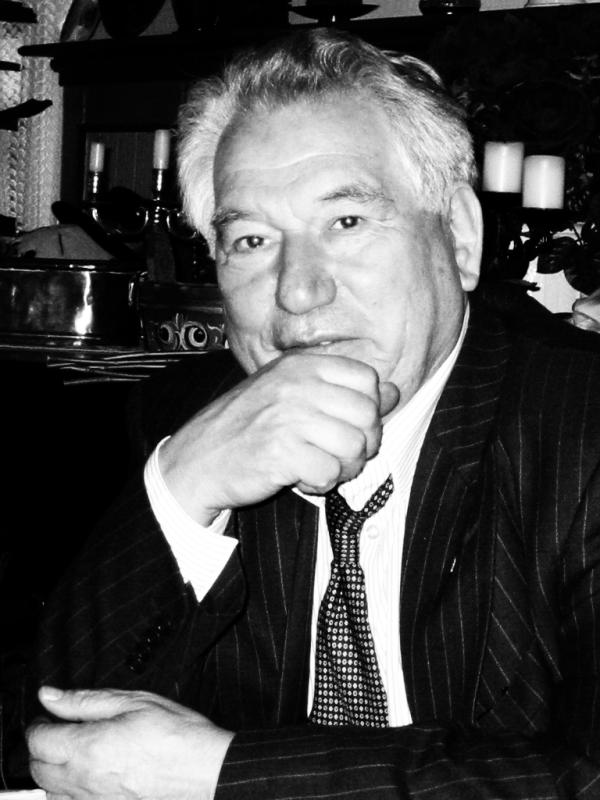Чингиз Айтматов

Давайте послушаем! Биография Чингиза Айтматова.
You will watch a short biography of Chinghiz Aitmatov, Kyrgyzstan’s greatest writer.
First acquaint yourself with some vocabulary that will appear in the video.
аул / аульный: village / relating to the village
грамотный: educated
диабет: diabetes
животноводство: animal husbandry
зоотехникум: animal technical school
опубликовать: to publish
повесть: long story
посол / посольство: ambassador / embassy
рассказ: story
редактор: editor
умереть: to die
фантастика: science fiction
Next watch the video. The video will stop periodically and ask you which facts from Aitmatov’s life you just heard in the previous clip. If you want, you can click a button to go back and watch the clip again.
Давайте поговорим! Биография Айтматова.
Поговорите с партнёрами:
- Когда́ и где Чинги́з Айтма́тов роди́лся?
- Что мы зна́ем о семье́ Айтма́това?
- Что случи́лось, когда́ Айтма́тову бы́ло 14 лет?
- Где Айтма́тов учи́лся?
- Что Айтма́тов изуча́л?
- В каки́х сфе́рах Айтма́тов рабо́тал?
- Когда́ он на́чал писа́ть?
- О чём он писа́л?
- Чем он боле́л в конце́ жи́зни?
- Где и когда́ Айтма́тов у́мер?
Упражнение 47. Обложки книг Айтматова.
You probably noticed from the biography video that Aitmatov worked with animals in his career, and his literary works are full of nature, including animals. Based on the titles, can you find some works that have animals as key figures?
Белое облако Чингисхана
Прощай, Гульсары!
Ранние журавли
Когда падают горы
Джамиля
И дольше века длится день
Солдатёнок
Верблюжий глаз
Плаха
Материнское поле
Белый параход
Пегий пёс, бегущий краем моря
Now look at the covers of his books, audio books, and films in this slideshow and check yourself. How many more of the titles have animals on the cover?
Follow-up activity:
One of Aitmatov’s stories is called «Проща́й, Гульсары́!». The Gulsary of the title is the name of the main character’s horse. In the story there is a passage about кок бору. Read the passage and its English translation if you need it, and see if it matches what you learned about кок бору.
| по-русски | по-английски |
| Со всех сторон кинулись к нему всадники, столпились, пытаясь подхватить тушу с земли. Но в давке сделать это было не так просто. Кони ошалело крутились, кусались, ощерив зубы… Гульсары изнывал в этой свалке, ему бы на простор, но Танабаю все никак не удавалось завладеть козлом.
И вдруг раздался пронзительный голос: «Держи, казахи взяли!» Из конной круговерти вырвался молодой казах в разодранной гимнастерке на карем озверевшем жеребце. Он кинулся прочь, подтягивая под ногу, под стремя, тушу козла. — Держи! Это карий! — закричали все, бросаясь в погоню. — Скорей, Танабай, только ты можешь догнать! С болтающимся под стременем козлом казах на карем жеребце уходил прямо туда, где алело закатное солнце. Казалось, еще немного — и он влетит в это пламенеющее солнце и растает там красным дымом. «Преклоняюсь перед мудрыми предками, оставивших нам эти игры мужественных. Да будут они благословенны!» |
From all sides, horsemen rushed toward him, crowding together, trying to grab the carcass from the ground. But in the crush, it wasn’t so easy. The horses spun around wildly, biting, baring their teeth… Gul’sary was struggling in the melee — he longed for open space, but Tanabai still couldn’t seize the goat.
Suddenly, a piercing voice rang out: “Hold him — the Kazakhs have taken it!” Out of the swirling mass of horses burst a young Kazakh in a torn military shirt on a dark brown, furious stallion. He galloped away, dragging the goat’s carcass under his leg, under the stirrup. “Get him! The dark bay!” everyone shouted, rushing into pursuit. “Quick, Tanabai, only you can catch him!” With the goat swaying beneath his stirrup, the Kazakh on the dark bay horse rode straight toward the place where the sunset glowed crimson. It seemed that just a little farther — and he would fly into that blazing sun and dissolve there like red smoke. “I bow to the wise ancestors who left us these games of bravery. May they be blessed!” |
Next you can watch the corresponding scene from a film based on the story. The film is called “Бег иноходца” (1968). The scene goes from minute 39 to minute 42:41.
Sources:
Чингиз Айтматов: by Andreas Zak (Tanuki), CC BY-SA 3.0, https://commons.wikimedia.org/w/index.php?curid=772490

